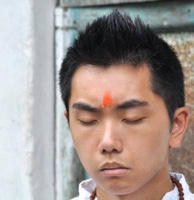Those who do yoga classes may find themselves struggling with the Lotus position.
In more traditional terms, this position is known as Padmasana.
For those of us who may have entered this life without a great degree of flexibility, we have surrendered to the modified Lotus—a.k.a “Indian Style” sitting.
The long and spindly-of-limb quaintly place one foot up on their left thigh and then the other on their right. But somehow, our legs don’t match up quite the same?
Are we different sorts of human? Absolutely not.
There are plenty of reasons why one cannot assume the proper Lotus position. In Western society, we’re prone to sit in chairs all day which degrades our legs ability to bend in that capacity on their own. We also don’t typically bend our legs in that manner for day-to-day activities.
But, more importantly, let’s discuss briefly why it is important to get to a place were we can do this pose.
If you’ve ever spent any significant amount of time in Indian Style, you’ll notice that your legs are resting their weight on one ankle. For a short period of time, this isn’t a problem. However, if you’re interested in gaining the fruit of meditation, that requires long periods of time holding an asana. And, as anyone who has ever attempted meditation for more than five minutes surely knows, a slow pressure grows into a sharp pain.
In Lotus, you are not burdened with this. Why? Because your weight is rested firmly on your ham hocks.
Your muscle and fat tissue are much more comfortable cushions than your nerve-endings. Regardless of how much cushion you have, the lotus position is completely possible for any body shape and any level of flexibility. It’s the best possible resting position because it affords you a much longer time to sit without strain on joints or bones.
Note: These exercises will require silly displays of bending! Be prepared to giggle and laugh!
Exercise 1: Foot to Thigh
Lie down flat on the ground, facing upwards. With your legs bent, feet on the ground, bring your right foot up and into your inner left thigh as deeply as you are able. Work on gentle, slow movement—bringing that heel up as far as you can while keeping it relatively stiff to the ankle. Focus on breathing in through your nose and out through your mouth. In Yoga, one of the fundamental principles is pranayama, which crudely translates to breathing, and it is absolutely essential for all the rest.
Once you have pulled your right foot in as deeply against your left thigh as you can manage, still on your back, pull your left foot into your right thigh. Don’t be frustrated! Don’t ever give into frustration or the thought you can’t do it. Focus instead on your breathing, and listen to your muscles and tendons tug and sway.
Now release. Let both of your legs go back down so your feet are rested firmly on the ground.
Exercise 2: Butterfly
Sitting upright, back arched, breathing in through the nose and holding, bring the flats of your feet together. On the exhale, gently apply pressure to the inner thighs with your elbows. Once you have exhaled completely, hold the negative space (the time when you have no breath in your lungs) for as long as you can. Inhaling back through the nostrils and releasing pressure, let your legs resume their natural position in the Butterfly.
Repeat this at least three to five times, using your own body’s natural rhythm to dictate how long you should hold a strained pose.
Exercise 3: Elevated Butterfly
For this variation, get back into the Butterfly position and place your hands beneath your ankles. On the inhale, lift up gently so all your weight is on your thighs and buttocks. Hold. Keep pulling up gently. Your goal is to bring your ankles to flush alignment with your hips—no further! When you release your breath, let your ankles back down to lie flat against your palms.
Repeat these exercises as often as you would like. If you find the Lotus position to be difficult, I recommend doing them often. These beginning stretches will help get your body acclimated to a new posture which will become the basis of your quest to find serenity and peace in this lifetime.
Most importantly, don’t be afraid to laugh! You may notice your body does not immediately obey you but it is learning.
And you, in time, will appreciate the fruits of both the Lotus position and meditation.
Love elephant and want to go steady?
Sign up for our (curated) daily and weekly newsletters!
Editor: Emily Bartran
Photo: Nicholas A. Tonelli/Flickr

 Share on bsky
Share on bsky





Read 2 comments and reply